Anacondas are large and intimidating constrictor snakes that squeeze prey to death instead of using venom. Their ability to hide their massive bodies below water and strike fast has made them the stuff of legends. Anacondas have even been featured in a film franchise, even though their abilities were greatly exaggerated. We’re going to show you ten incredible anaconda facts that are even more impressive than fiction. Learn all about these amazing snakes and see why they’re both respected and feared!
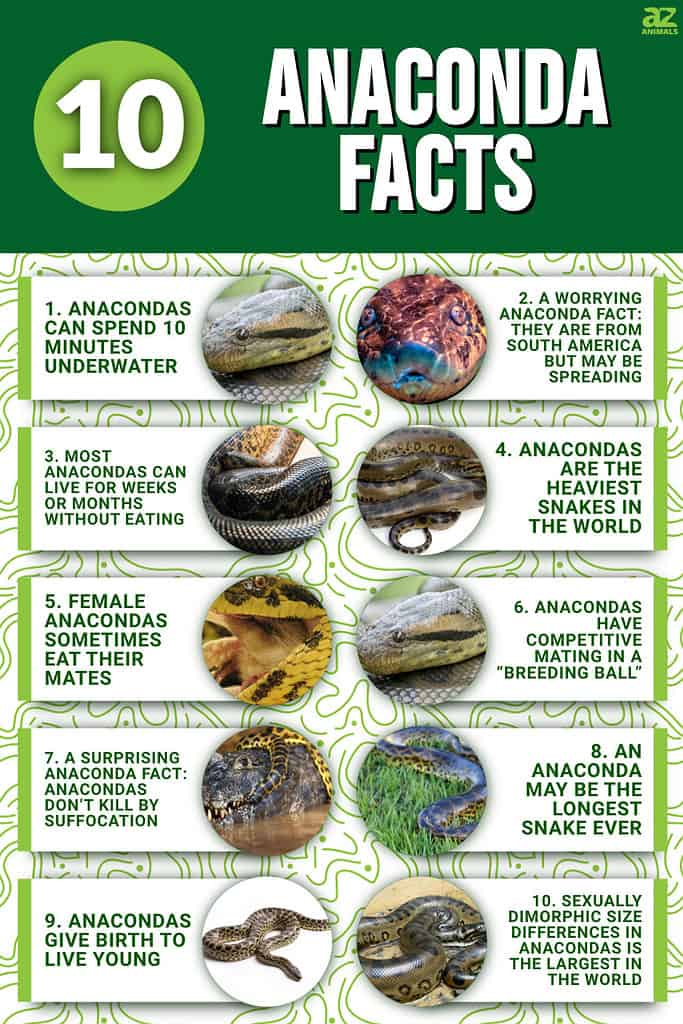
The Top 10 Incredible Anaconda Facts
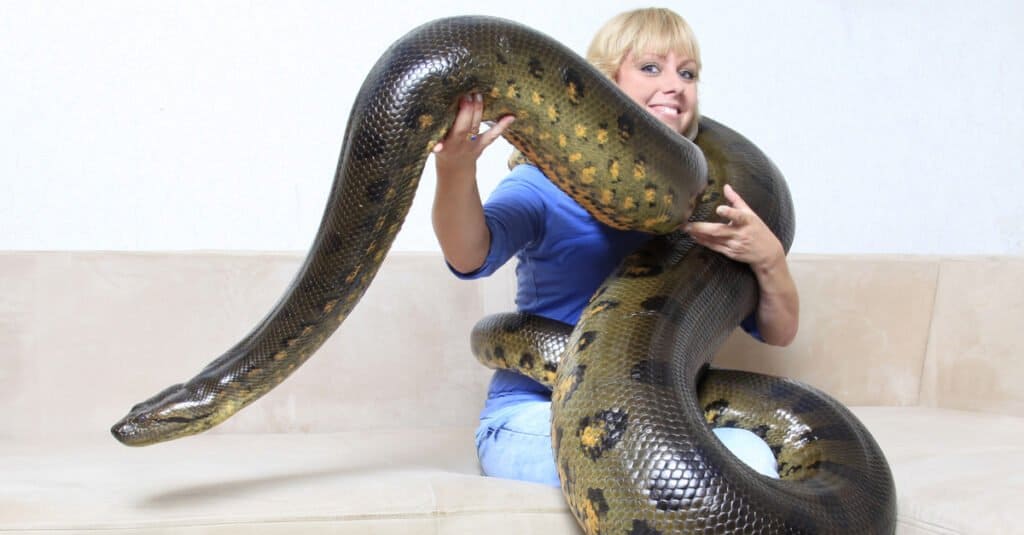
Anacondas are incredibly and thick snakes from South America
©Holger Kirk/Shutterstock.com
Snakes are very interesting reptiles. They can be some of the deadliest creatures on the planet, survive inhospitable habitats, and have a form of mobility that seems to counter their hunting prowess. The anaconda is one of the most interesting species of snake. Learn about 10 incredible anaconda facts and see why they’re such wonderful creatures.
10. Sexually Dimorphic Size Differences in Anacondas is the Largest in the World
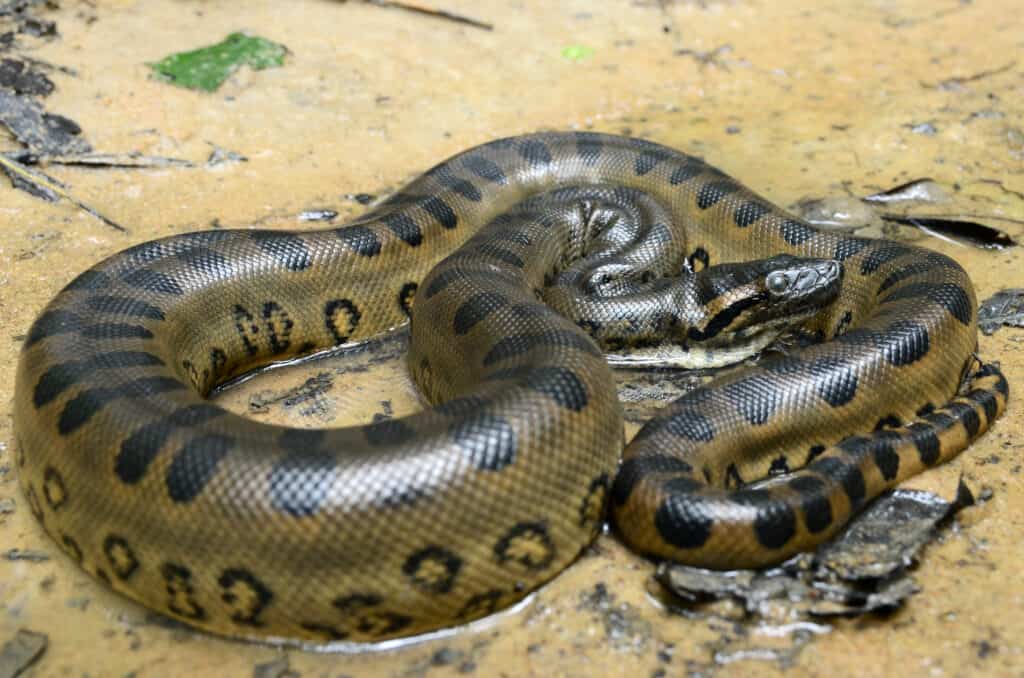
Anacondas have a significant difference in size between males and females.
©Patrick K. Campbell/Shutterstock.com
Female anacondas are almost always larger than male anacondas within a given species. For example, the average length of a female anaconda is about 15 feet. A male will typically grow about 9 feet in length. This size-based sexual dimorphism represents the largest differential of its kind in any animal.
Thus, if a record-breaking anaconda appears in the world, the chances are very high that it is a female.
9. Anacondas Give Birth to Live Young

Anacondas give birth to their babies.
©cellistka/Shutterstock.com
Most snakes lay eggs when they reproduce, but some are ovoviviparous and give birth to their young. Each young anaconda grows inside its mother, surrounded by a membrane with its own yolk sack.
So, instead of laying eggs, the babies are born when they’re ready. Just like other snakes, anaconda babies are ready to go nearly from birth.
8. An Anaconda May Be the Longest Snake Ever

The head and neck of the
snake direct its body when moving
.
©iStock.com/Schumaher
Although a few Burmese pythons have received somewhat reliable measurements exceeding 25ft, one anaconda may have been longer. According to one news story from Brazil, it seems that workers at a construction site found an anaconda that measured 33ft long! Unfortunately, the snake was killed, and no scientific analysis took place on the creature.
The snake was said to have a head that was a full 3ft across and a weight of 880lbs! If those measurements were true, then this was the longest snake ever found and certainly the heaviest!
7. A Surprising Anaconda Fact: Anacondas Don’t Kill by Suffocation
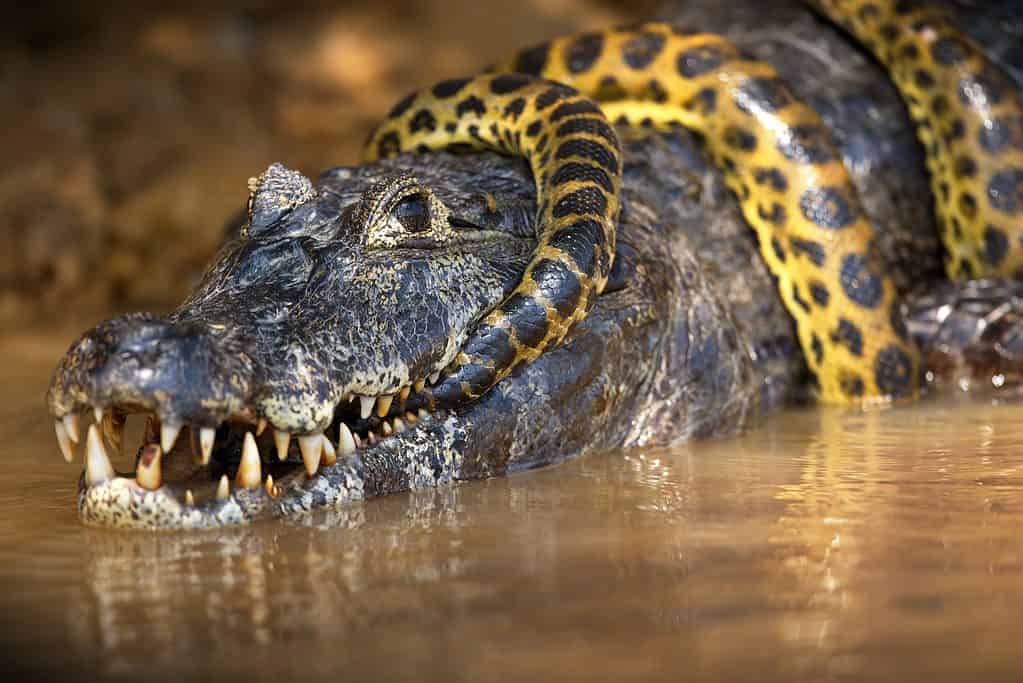
Anacondas can survive underwater for up to 30 minutes at a time, but their prey cannot.
©Wirestock Creators/Shutterstock.com
A common misconception about anacondas is that they kill their prey by squeezing it to death. However, that’s not true. They do not wait for their prey to exhale and then ratchet their squeeze to kill them.
Being that anacondas will often attack creatures from the water, one of their favored methods of attack is to drown their prey. Anacondas can survive underwater for about 30 minutes at a time, but their prey cannot. Also, anacondas can kill by overwhelming the circulatory system of their prey’s body. They squeeze so hard that the heart can’t pump blood outward.
6. Anacondas Have Competitive Mating in a “Breeding Ball”

Female anacondas will choose one male out of many.
©Mark_Kostich/Shutterstock.com
When the time comes to mate, anacondas don’t select a single mate with whom to breed. Instead, they will form a mass of multiple male snakes and one female at the center. When she chooses the male that is largest and has the best characteristics, she will then allow him to mate with her.
This competition and mating process can last for up to a month, and the female will mate several times during that period to ensure fertilization.
5. Female Anacondas Sometimes Eat Their Mates

Female anacondas will, albeit rarely, eat a male.
©Ariawesomeness/Shutterstock.com
The massive difference in sexual dimorphism combined with the long period of time that is spent without eating leads to some females eating their mates. These snakes need to get their fill of food after spending all that time in the mating ball and for the gestation period that lies ahead.
This cannibalism isn’t extremely common. However, it always occurs with the much larger female eating smaller males.
4. Anacondas Are the Heaviest Snakes in the World
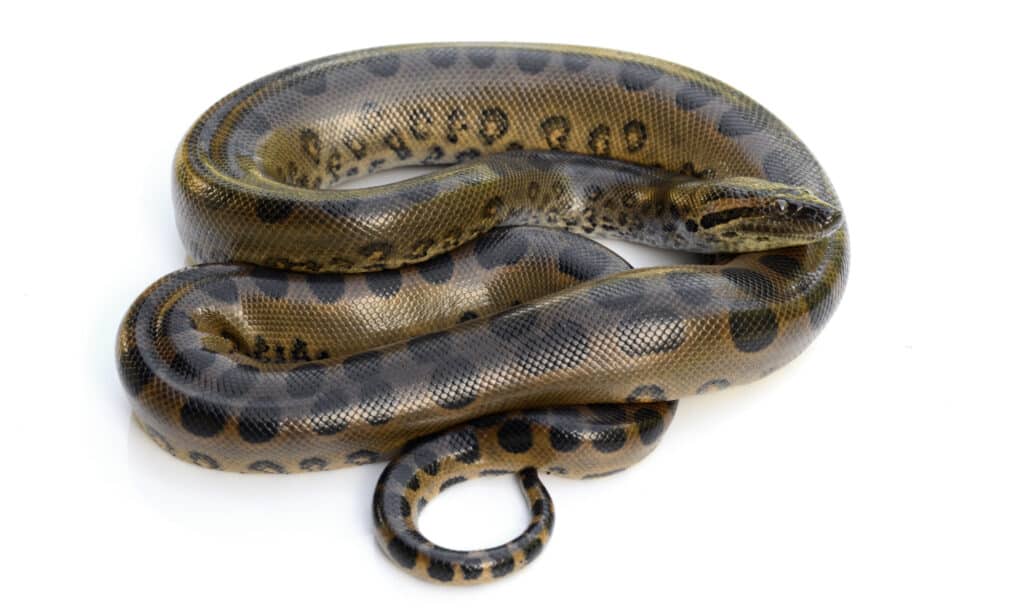
These snakes can weigh several hundreds of pounds!
©Patrick K. Campbell/Shutterstock.com
Even if you erased the potential longest snake record off the books, anacondas are still the heaviest snakes in the world. Reticulated pythons and Burmese pythons are incredibly long snakes. Yet, they are rather thin, so they don’t weigh that much.
Anacondas are massive, thick, muscular snakes that can weigh up to over 500lbs. If we do count the previously mentioned snake record, then one anaconda reportedly weighed almost 900lbs!
3. Most Anacondas Can Live for Weeks or Months Without Eating
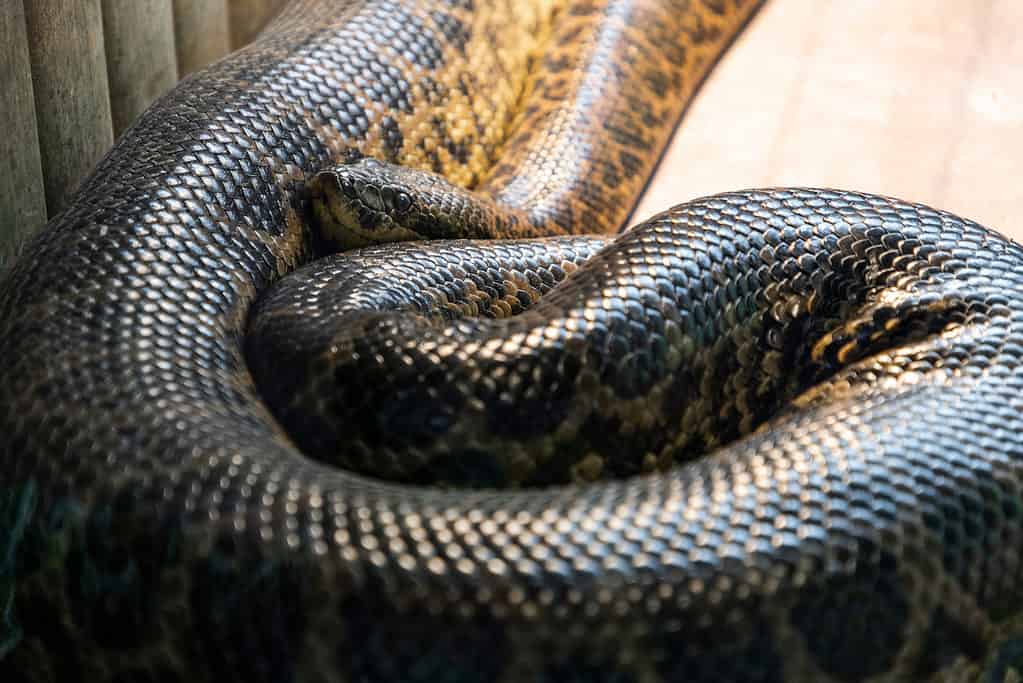
Anacondas are laconic during the day, becoming more active at dusk and nightfall.
©zlatkozalec/Shutterstock.com
Anacondas can hunt and kill very large prey including deer. That means they do not need to eat that often after securing a kill. Anacondas have a very slow metabolism, so they can comfortably survive for several weeks.
Anacondas have increased metabolism when they are breeding. That helps explain why the females may eat the males after the breeding session has concluded.
2. A Worrying Anaconda Fact: They Are from South America but May Be Spreading
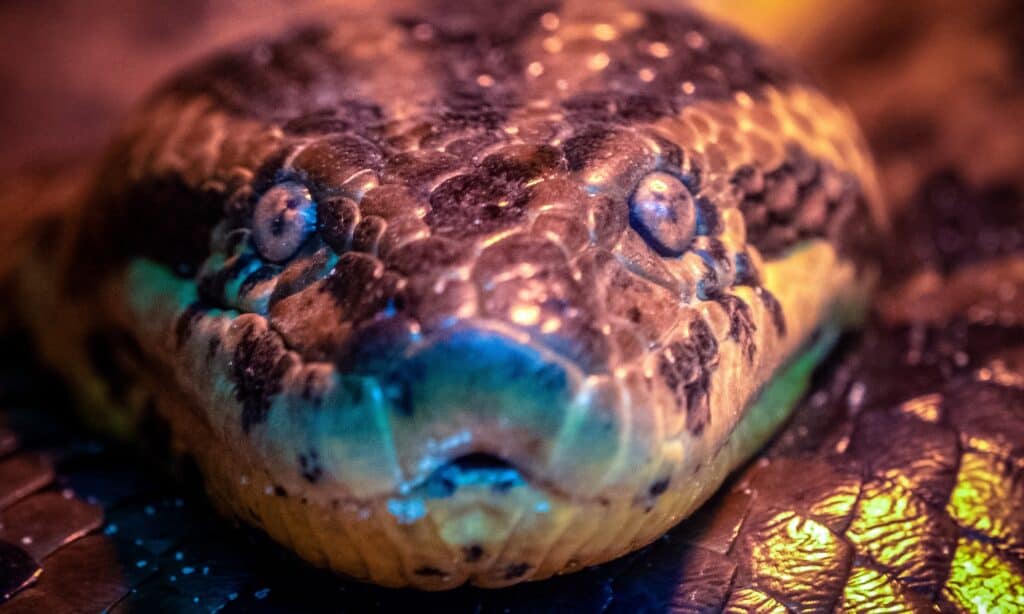
Anacondas have been found in the Florida Everglades.
©iStock.com/4uves
Originally, anacondas are from South America in countries east of the Andes Mountains. They live in a similar area to the prehistoric Titanoboa. Up until a few decades ago, South America was the only place where these snakes lived.
Unfortunately, yellow and green anacondas have been found in the Florida Everglades as an invasive species. They were probably released in that area by former pet owners. Whether they become as numerous as the Burmese pythons in the area remains to be seen.
1. Anacondas Can Spend 30 Minutes Underwater

Anacondas have eyes high on their heads so they can sit and wait for prey to appear from the water.
©Mark_Kostich/Shutterstock.com
Despite their massive weight and size, anacondas are ambush predators. They hide most of their body under the water and then strike their foes. They can wait completely under the water for 30 minutes, leaving only their eyes looking out. When they find something suitable to eat, they will lunge from the water, grab the prey, wrap it up, and kill it.
Anacondas are very interesting and dangerous creatures. However, no records exist of them harming human beings. Most of them live in very remote places. The chances of you running into the snake in the wild are very low. Even if you did find one on land, you could get away by quickly and calmly retreating.
The photo featured at the top of this post is © Patrick K. Campbell/Shutterstock.com
Discover the "Monster" Snake 5X Bigger than an Anaconda
Every day A-Z Animals sends out some of the most incredible facts in the world from our free newsletter. Want to discover the 10 most beautiful snakes in the world, a "snake island" where you're never more than 3 feet from danger, or a "monster" snake 5X larger than an anaconda? Then sign up right now and you'll start receiving our daily newsletter absolutely free.
Thank you for reading! Have some feedback for us? Contact the AZ Animals editorial team.






